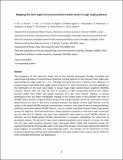Mapping the twist-angle disorder and Landau levels in magic-angle graphene
Author(s)
Uri, A; Grover, S; Cao, Y; Crosse, JA; Bagani, K; Rodan-Legrain, D; Myasoedov, Y; Watanabe, K; Taniguchi, T; Moon, P; Koshino, M; Jarillo-Herrero, P; Zeldov, E; ... Show more Show less
DownloadSubmitted version (5.514Mb)
Open Access Policy
Open Access Policy
Creative Commons Attribution-Noncommercial-Share Alike
Terms of use
Metadata
Show full item recordAbstract
© 2020, The Author(s), under exclusive licence to Springer Nature Limited. The recently discovered flat electronic bands and strongly correlated and superconducting phases in magic-angle twisted bilayer graphene (MATBG)1,2 crucially depend on the interlayer twist angle, θ. Although control of the global θ with a precision of about 0.1 degrees has been demonstrated1–7, little information is available on the distribution of the local twist angles. Here we use a nanoscale on-tip scanning superconducting quantum interference device (SQUID-on-tip)8 to obtain tomographic images of the Landau levels in the quantum Hall state9 and to map the local θ variations in hexagonal boron nitride (hBN)-encapsulated MATBG devices with relative precision better than 0.002 degrees and a spatial resolution of a few moiré periods. We find a correlation between the degree of θ disorder and the quality of the MATBG transport characteristics and show that even state-of-the-art devices—which exhibit correlated states, Landau fans and superconductivity—display considerable local variation in θ of up to 0.1 degrees, exhibiting substantial gradients and networks of jumps, and may contain areas with no local MATBG behaviour. We observe that the correlated states in MATBG are particularly fragile with respect to the twist-angle disorder. We also show that the gradients of θ generate large gate-tunable in-plane electric fields, unscreened even in the metallic regions, which profoundly alter the quantum Hall state by forming edge channels in the bulk of the sample and may affect the phase diagram of the correlated and superconducting states. We thus establish the importance of θ disorder as an unconventional type of disorder enabling the use of twist-angle gradients for bandstructure engineering, for realization of correlated phenomena and for gate-tunable built-in planar electric fields for device applications.
Date issued
2020Department
Massachusetts Institute of Technology. Department of PhysicsJournal
Nature
Publisher
Springer Science and Business Media LLC